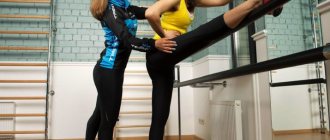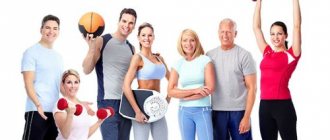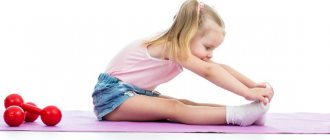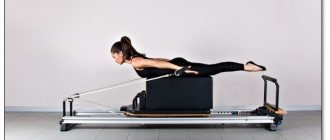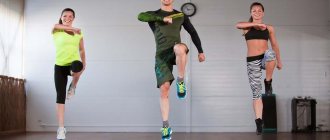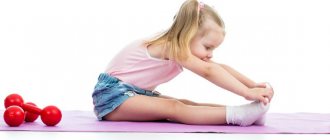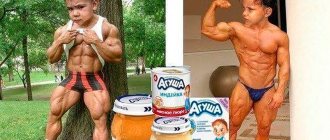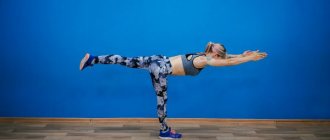Strength training for children
DetailsCategory: Health 1568
Strength training for kids? Nothing surprising. Of course, kids don't need to lift heavy dumbbells and try to reach the levers of exercise machines.
Simple exercises that allow you to exercise using your own body weight and careful adherence to safety precautions will make your child stronger and improve his metabolism. This will help you effectively control your body weight and grow healthy.
Why do kids need strength training?
This type of training, along with developing endurance and agility, improves bone mineral density, regulates blood cholesterol and helps maintain a healthy body weight.
Is your child already involved in a sports section? Strength training will increase his performance and improve his results.
Teenagers and weight training equipment
Alexey Korochkin, a researcher at the Department of Exercise Therapy and Sports Medicine at the Russian State Medical University, talks about how to properly start strength training for teenagers.
If safety precautions are followed during training, and the classes themselves are structured correctly, they will not cause any harm to the growing body.
How and when to exercise?
Even kids between the ages of three and five can start strength training. This doesn't mean they have to lift weights! Simple exercises that use your own body weight to load are enough: push-ups, pull-ups, leg and body lifts.
Between the ages of six and nine years, children can begin to use various sports equipment to increase the load: simple expanders, light dumbbells, various balls, gymnastic sticks, as well as any other light weight objects at hand.
Safe Strength Training for Children
When working with a child of any age, it is very important that all exercises are performed correctly and slowly. Make sure your child understands well how to do the exercises, is physically able to do them, and listens carefully to your instructions.
Never leave your child unattended during classes!
Make sure your child understands well how to do the exercises, is physically able to do them, and listens carefully to your instructions. Never leave your child unattended during classes!
Two or three strength training sessions a week are enough for your baby. Explain to him how important regular exercise is. To do this, we can give an example of heroes from movies and cartoons who are distinguished by strength and endurance.
Advice!
To make your workouts more fun, train “like Boniface the Lion,” “like Batman,” or any other character. Review your favorite films or cartoons with your child and select exercises for a real hero.
If your child goes to a sports section, be sure to coordinate with the coach the introduction of strength training. In addition, ask him to give recommendations on safety precautions, selection of exercises and training regimen.
Sports without injury
Physically active children often get injured. However, a significant portion of these injuries are avoidable. Find out how.
Sample lesson plan for a child from six to nine years old
1. Five to ten minutes of warm-up: brisk walking, jogging in place or jumping rope.
2. Exercises with a gymnastic stick or ball to train the main muscle groups: arms, shoulders, legs, stomach, upper and lower back, chest.
3. Exercises to develop balance and improve range of motion. One exercise each for the main joint groups: joints of the arms, legs, spine.
5. Five to ten minutes of cool-down and some simple stretching exercises.
The most important
Properly constructed strength training will allow your baby to become stronger and more resilient. An important point for a teenager should be to quickly gain muscle mass. Don't forget about safety precautions and practice together with your child.
General developmental gymnastics
The largest and most popular group of exercises are general strengthening (basic) gymnastic elements. They are used to increase performance, improve and maintain physical fitness, and improve human health. As a result of regular training, blood circulation is activated, the respiratory system is stimulated, and the psycho-emotional background is stabilized. By doing this kind of gymnastics regularly, you will significantly strengthen your muscle mass and increase the tone of your entire body.
General developmental gymnastic exercises are performed without objects or using various sports equipment. There are many options for such training with a ball, jump rope, hoop, sticks, wall bars or bench. They are widely used as a warm-up before more intense physical activity. Performing general developmental exercises does not require special training or sports skills, unlike other types of gymnastics, for example, rhythmic or athletic. These elements have proven themselves to be the main means of maintaining the performance of older people.
A set of exercises for children at home
Let's consider a simple home workout option for a child:
- Starting position – feet stand shoulder width apart. The left (after – right) leg bent at the knee should be raised and touch it to the elbow of the right (after – left) hand. The exercise is repeated six times for each side.
- Hands on the waist, feet positioned wider than shoulder level. The right leg slowly bends at the knee, the body weight is transferred to it, while the left leg stands on the toe. After returning the body to its original position, the exercise is repeated on the other side. Number of repetitions: five times on the right and left legs.
- Starting position – lying on your stomach, arms extended forward. It is necessary to simultaneously lift the upper and lower limbs off the floor and fix the position of the body at the maximum point of lifting for several seconds. The optimal number of repetitions for this exercise is six times.
- Feet stand shoulder-width apart, hands on waist. With your feet turned outward and your back straight, you should sit on your toes and stretch your arms forward. Next you need to return to the starting position. The exercise is repeated six to eight times.
- Feet shoulder-width apart, back straight, holding a gymnastic stick in your hands. You should alternately step over the sports equipment with each foot, while trying to keep the stick as close to the ends as possible. The optimal number of repetitions for this exercise is 10 times for each leg.
So, children's fitness is a relatively new, but at the same time very effective approach to organizing the training process for preschool children and primary and secondary school students. This form of training has nothing to do with professional sports; its goal is to strengthen the health of children and promote their comprehensive development (including psycho-emotional).
Each child can choose the type of training that suits his or her liking – dancing, gymnastics, aerobics, yoga, etc. Fortunately, modern fitness centers offer a wide range of services of this kind at an affordable cost. Fitness is a great way to keep a child busy, direct his energy “in the right direction” and ensure his healthy, full-fledged development.
Video “Children’s fitness from 14 months to 3 years with Anna Razuvanova”:
Previous TheoryFitness over 50: features for older people Next TheoryHow to do fitness at home - everything you need in one article
Enlarges breasts by 1-2 sizes and shapes posture. Creates ideal curves of the waist and hips. Get 3 sizes slimmer without effort! Buy
Revolutionary technology for losing weight at home. Lose excess weight without dieting or training! In just 23 minutes a day. Buy
Sports nutrition for people who prefer an active and healthy lifestyle. High quality products from famous brands. Buy
Breathing exercises for children: effective exercises and technique
A completely healthy child is a rarity today. Any pediatrician will tell you this. The state of the environment, stress, computer technology, gadgets almost from the cradle - all this cannot but leave its mark on the health of children. Therefore, more and more parents are interested in how to improve their baby’s health, strengthen his immunity and help him cope with diseases. One of the effective methods that helps achieve both therapeutic and therapeutic-prophylactic goals is breathing exercises for children. In this article we will tell you how and why to conduct it and whether it is possible to organize classes yourself.
What it is?
Breathing exercises are a system of exercises based on spontaneous activation of the functions of the respiratory organs. The oxygen saturation of all organs and systems of the child’s body largely depends on the functioning of the lungs, bronchi and upper respiratory tract. Even the healers of Ancient Greece drew attention to the fact that a person’s well-being depends on a person’s breathing. Over several millennia, medicine has developed a large set of breathing exercises that can help with a wide variety of diseases and conditions. Children's breathing exercises are widely used to prevent frequent colds, as it strengthens the respiratory system, increases lung capacity, and strengthens muscles. Breathing exercises help avoid hypoxia - the child’s body receives a sufficient amount of oxygen. First of all, the benefit of this lies in improving the functioning of the cerebral cortex, heart, digestive organs and central nervous system. A child who does breathing exercises has much more self-control, and this is an indisputable fact. In an emergency situation, it is much easier for such a child to take deep, slow breaths to cope with stress. The beneficial effect of exercises on the nervous system has been noticed for a long time, and therefore breathing exercises have become mandatory for stuttering, neurasthenia, and hysteria. Gymnastics allows you to recover faster after adenoid surgery, after removal of the adenoids. It acts as an auxiliary treatment and shows excellent results for bronchitis, pneumonia, bronchial asthma, as well as during the recovery stage after an acute period of other respiratory diseases. Speech therapy breathing exercises in combination with a special facial massage allows the child to cope with problems such as dysarthria and delayed speech development. Since the basis of any breathing exercises is nasal inhalation and exhalation, during which the receptors of the nose, nasopharynx, and pharynx are actively stimulated, the child’s local and general immunity increases. After just a few months, it becomes noticeable that the child begins to get sick less. For children of preschool and school age, breathing exercises are introduced into warm-ups and physical education classes to restore breathing. Breathing exercises are usually not prescribed for children in the first year of life, since it is difficult for children at this age to explain the rules of special, healthy breathing, but from the age of 2.5-3 years, 3-4 years and older, children cope well with the tasks. Types There are several main types that are most widespread among children. The undisputed leader is the breathing exercises of Alexandra Strelnikova. The phoniatrist teacher initially came up with a set of exercises for those who study vocals, but the technique turned out to be useful for treatment - Strelnikova’s own daughter, suffering from a heart disease, was able to noticeably improve her condition using her mother’s technique. Strelnikova’s gymnastics is appreciated by doctors all over the world, calling it “Russian gymnastics.” It is recommended to ease breathing when coughing of any origin. Gymnastics is valued by athletes, singers, and actors. For children, the technique has found the widest application. The method is based on inhalations of different depths and frequencies, alternating nasal and oral inhalations and exhalations. Correct inhalations and exhalations according to Strelnikova’s method are recommended for pregnant women to get rid of toxicosis and master breathing during childbirth. In childhood, such gymnastics has its own indications and contraindications, which we will discuss below. Another type of breathing exercise is gymnastics according to K. Buteyko. Konstantin Buteyko is a physiologist who, in the middle of the last century, discovered his own method of treating diseases with breathing exercises. The doctor was convinced that the cause of illnesses was deep breathing, and therefore his system was based on suppressing deep inhalations and exhalations. The Buteyko method of shallow breathing is not recommended for children from a very early age. The optimal age for starting classes is considered to be 4-5 years and older. The method allows the child not only to get rid of respiratory diseases that torment him, but also from skin ailments - allergies, dermatitis. Also, some parents quite successfully practice breathing exercises from hatha yoga, Chinese qigong gymnastics and many others. According to their purpose, breathing exercises can be divided into: general strengthening, preventive; medicinal; speech therapy; developing. According to the technique of execution, all breathing exercises can be dynamic and static. The first ones are performed strictly in motion, combined with exercises or gymnastics. Static ones are done at rest - breathing exercises at this moment are the only load. Contraindications Before starting breathing exercises at home with your son or daughter, the mother should definitely consult a pediatrician to rule out any contraindications for the preschooler or schoolchild. Circumstances that prevent independent practice of breathing exercises include the following diseases and conditions: some heart defects (for classes using the Strelnikova method); renal failure; myopia, glaucoma (for the Strelnikova method); severe vascular and blood diseases; mental illness; acute period of illness (with high temperature, fever); diabetes mellitus (for the Buteyko method); chronic tonsillitis (for classes using the Buteyko method). Up to 5 years of age, classes should contain only some elements of breathing practices. Doctors recommend practicing full-fledged breathing exercises from the age of 5-6, and its complex forms, which are present in some types of yoga, not earlier than 6-7 years and older. You cannot start a lesson if the child has not gotten enough sleep, if he does not feel well, if he is in a bad mood and is not in the mood to play and study. The child will not forcefully perform the exercise as needed, and accordingly, achieving the desired result will be almost impossible. Do not leave your child alone, carefully monitor his well-being during the exercises. If his face turns pale or red, there is difficulty breathing, dizziness, fainting, trembling in the hands, numbness in the limbs, the activity must be stopped immediately and, if necessary, call a doctor. How to practice? If there are no contraindications, and the attending doctor fully approves of your idea of doing breathing exercises with your child, you need to choose the program that you would like to do - several types were described above. If you can’t settle on one method and want everything at once, you can start classes using a universal complex, which includes the best and most interesting exercises for children from various methods. We'll tell you more about it below. The task of parents is to teach the child to breathe as the technique of a particular exercise implies. It is best to do this in a playful way so that the child finds it interesting to study, otherwise he will quickly become disappointed in the classes and will not want to take part in them. Let's look at the general rules that are best learned before starting practice. Plan your time so that your child starts breathing exercises no earlier than an hour and a half after the next meal. You can exercise up to two times a day. The duration of the lesson at the initial stage should not exceed 10 minutes. Gradually, the training time is increased, the exercises themselves become more complicated, and new techniques are added. The maximum gymnastics time is 30 minutes. Breathing exercises require mandatory adherence to recommendations on techniques for performing techniques, but only at the initial stage. Then the mother may well, to the best of her own imagination, come up with any other exercises that her son or daughter will like, based on the techniques studied and mastered. If it's summer, go to exercise outdoors - the benefits will be much greater. In winter, when gymnastics is done in a room, be sure to ventilate the room before starting the session. The air temperature in the room should not exceed 21 degrees Celsius - intensive inhalation of warmer air can lead to drying out of the mucous membranes of the respiratory organs and the development or aggravation of respiratory diseases. The best example is, of course, your own example. Perform techniques together. A set of exercises Mothers often wonder whether they can start practicing on their own. When it is possible to conduct the first session in the presence of a teacher, doctor or breathing exercises instructor, take advantage of it. If this is not possible, it’s okay - all the exercises are quite simple, you can easily start practicing them yourself. Let's start with the complex for the youngest preschoolers. "Ball." This exercise is named after the image that the baby should keep before his eyes. The ball will become his own tummy at the moment of a deep breath. Ask your baby to lie on his back and place a small soft toy on his stomach. Slowly inhaling through the nose, the child should inflate the “ball” as hard as possible, and then just as slowly deflate it, exhaling through the mouth, with his lips folded into a tube. "Scuba diver." This exercise can be performed in any position - standing, sitting, lying down. Ask your child to imagine going into water. Let him take in as much air as possible and hold it for as long as possible - the mother counts down out loud, praising the child if today he managed to hold the air at least a second longer than yesterday. "A light feather." For this exercise, you will need a real feather from a pillow or a small balloon (by the way, you can inflate it with your child!). The goal of the game is to keep the ball or feather in the air for as long as possible, making short and intense exhalations. Everyone blew on a feather in childhood, and therefore the technique of performing this exercise will not cause any great difficulties. Exercises for children over 5 years old may also include the above techniques. In addition, other exercises are added, which, in their essence, are combined. "Closer and further." This exercise can be done in a sitting or standing position. Ask your child to inhale the air through his nose as if he is inhaling the scent of a wonderful flower. Exhale through your mouth, pursing your lips into a tube. At the same time, the child should exhale more intensely, as if he were pushing some light object away from himself. "Hamster on the hunt." This exercise is usually very popular with children. Ask him to pretend to be a hamster, puffing out his cheeks as much as possible. Then the baby lets out the air sharply, slapping his cheeks with his palms. The imaginary rodent goes for a new portion of “supplies” after preliminary sniffing - the child takes a series of small and frequent breaths through his nose. "Dragon Tosha." This exercise should be performed with children who have a clear idea of what a dragon looks like. Tell him that the dragon fell ill and can now breathe fire only through one nostril. This is what the game will consist of - alternate exhalations through one nostril (the second is covered with a finger). "Fists." This technique is performed simultaneously with the movement. Ask your child to stand and stretch his arms forward. Inhalation is done in a series of four short sharp breaths, and exhalation is done in any convenient way. During inhalations, the fists are rhythmically clenched and unclenched. There is also a separate group of exercises that are designed to develop speech and improve the pronunciation of individual letters and sounds. Here are a few of them. "Geese are flying." The mother invites the child to imagine himself as a goose flying high. At the same time, she reads the poem “Geese, geese will fly, they will look at Seryozha (Marina, Natasha, Irina, Alyosha, etc.).” On the first line, the child takes a breath and makes movements with his hands, like a goose with its wings. On the second line, you need to exhale with the sound “gu-u-u-u-u”, lower your arms along the body. "Watch". The mother asks the child to imagine that his hands are the hour and minute hands. One hand is raised up, the other is moved to the side (three o'clock position). Then they change it (the “nine o’clock” position). Inhale in the first position, exhale in the second. Mom reads a poem: “They will show the exact time, they will indicate the hour and day.” When exhaling, the child should pronounce a sound that is difficult for him (“la-la-la” or “r-r-r”). "Police officer". Mom reads a poem: “I keep order, I look left and right. If anything happens, I’m here to help!” The child, in a standing position, makes rhythmic turns of his head to the right and left. For each turn you take an inhale, and for the next one you exhale. The exhalation is accompanied by a drawn-out “zhu-zhu-zhuuuu”. Reviews Many mothers regularly use breathing exercises in their daily activities and games with preschool children and primary schoolchildren. They note that the results do not become noticeable very quickly. If you play with your baby every day and breathe correctly for at least 15 minutes, then noticeable results will appear only after six months to a year. But it’s worth it, say experienced mothers on thematic forums. Especially for children who stutter, shy and timid, who find it difficult to maintain normal breathing in moments of excitement and stress, in an unfamiliar group, Moms are generous with inventions. They willingly share their personal exercises, invented independently, with others on specialized forums. Therefore, there should be no problems with a variety of activities for the child. Quite rarely, parents note that children do not want to do breathing exercises. This usually happens if the mother failed to make the classes interesting from the beginning. You can correct the situation at any stage by simply reviewing your own approach to breathing exercises. If the whole family is passionate about it, the child is unlikely to refuse to support the idea. COMPLEXES OF BREATHING EXERCISES FOR CHILDREN Breathing exercises are useful not only for the prevention of colds, bronchitis and sinusitis, they teach the child proper breathing. It is not without reason that elements of breathing exercises are necessarily included in a set of exercises in physical education classes. ✨ Preparatory exercise Starting position. Standing, sitting or lying down. Performance. Close your eyes, try to calm down, relax. We take a deep breath and hold our breath as much as possible. We perform 5-10 times. ✨ Exercise “Balloon” Starting position. Standing, sitting or lying down, place your hands on the bottom of your ribs. Performance. Before performing the exercise, you need to exhale air from the chest through your mouth so that it retracts. Then slowly inhale through the nose and exhale through the mouth. When performing the exercise, be sure to ensure that your stomach and shoulders remain motionless. We perform the exercise 6-10 times. ✨ Exercise “Window and door” Starting position. Stand up straight, straighten up. Performance. In this exercise, air enters through the “window” and exits through the “door.” First, the “window” is the left nostril, and the “door” is the right. With your right hand we close the right nostril, slowly inhale through the “window”, then with our left hand we close the left nostril and slowly release the air through the “door”. We perform 4-6 times. Then the “window” and “door” change places. ✨ Exercise “Clock” Starting position. Standing, feet shoulder-width apart. Performance. We swing our arms forward and backward with straight arms, while repeating “Tick-tock.” We perform 10-12 times. ✨ Exercise “Cheerful Cockerel” Starting position. Standing straight, arms down along the body. Performance. We raise our hands up and then slap them on our thighs. As you exhale, say: “Ku-ka-re-ku.” We do it 5-6 times. ✨ Exercise “Blowing the shoulders” Starting position. Standing, feet shoulder-width apart, arms down along the body, head straight Execution. We inhale, then turn our head to the left, exhale through our mouth, while our lips are curled into a tube. We continue to perform this exercise in the following order: the head is straight - “inhale”, the head is turned to the right - “exhale”, the head is straight - “inhale”, we lower the head to the chin - “exhale”, the head is straight - “inhale”, we raise the head up – “exhale”, head straight – “inhale”. We perform the exercise 5-10 times. ✨ Exercise “Pump” Starting position. Standing, legs together, arms down along the body Execution. We inhale, then exhaling, we bend to the side, the crayfish move along the body, and as we exhale we say: “Ssssss...”. We perform the exercise 6-8 times in each direction. ✨ Exercise “Stretch” Starting position. Standing, feet together, arms raised up Execution. As you inhale, we pull ourselves up well, rise on our toes, as we exhale, we lower our arms, stand on our entire foot, and say: “U-h-h...” We do this 4-5 times. ✨ Exercise “The steam locomotive is going and going” Execution. We walk in a circle, imitating a steam locomotive, making appropriate movements with our hands and saying “Chuh-chukh-chukh”. Perform for 20-30 seconds. ✨ Exercise “Bugler” Starting position. Standing or sitting, fold your hands near your mouth, depicting a forge. Performance. We exhale slowly and say loudly “Pff-ff.” We do it 4-5 times. ✨ Exercise “Tree in the Wind” Starting position. Sitting on your knees or on your heels. Performance. During inhalation, we raise our arms up; during exhalation, we lower our arms, while the torso bends slightly. ✨ Exercise "Hippo" Starting position. Lying on the back, closing his eyes, putting his hands on his stomach. Performance. Slowly and smoothly inhale, the tummy is inflated when inhaling. After that, we also exhale slowly and smoothly so that the tummy is drawn.
Children's workouts
How to teach a child to skate?
Read how to teach your child to skate as quickly, correctly and easily as possible, so that your child has fun and enjoys the process. Find out what the most important skills a future figure skater or hockey player must master to safely move on the ice.
Sports equipment for kindergartens
All children need to be taught a love of a healthy lifestyle from an early age. Therefore, in preschool educational institutions there is a gym, which should have all the necessary equipment for the children. We will tell you how to equip a kindergarten gym later in the article.
Exercises in kindergarten
Physical exercise strengthens the body and has a positive effect on the child’s immune system. That is why systematic and moderate physical activity in kindergarten is so important. Read on for some recommendations to help make these activities more useful and interesting.
Teaching preschool children swimming
Kids learn everything very quickly at an early age, grasping everything on the fly. The ideal time to teach children to swim is 3-5 years old. Today you will learn how you can teach a preschool child to swim - read about it further in our article.
Healthy lifestyle for children
The formation of a healthy lifestyle originates from childhood, when day after day the whole family lives in the usual rhythm of life, observing established norms and rules, and then over time such norms will become the essence of the child, his integral part.
Football section for children
Football is the most popular and beloved sport. A simple game creates a general load on the body and contributes to the psychological development of the individual. Next, we will tell you when you can start classes in the section and what you need to be prepared for when sending your child to such training.
Relay races for children
To help children have fun and usefully spend their time, organize a sports relay race for them. Children of all ages really like these types of games. In good weather they can be held outdoors. Further in the article we will tell you several ideas for holding such games.
Physical exercises in elementary school
In order to relieve visual, mental and physical stress in a child, it is necessary to carry out physical exercises
They will briefly distract the student from the learning process, but will not completely switch attention, and this is important, since they are carried out in the middle of the lesson.
Aggression in children
When faced with manifestations of aggressive behavior in children, many parents are confused. How to respond to this behavior and how can it be corrected? Let's try to figure this out in our article.
How to teach a child to ride a bike
Riding a bicycle will help develop your child's muscles and improve coordination of movements. You should start introducing your child to a bicycle with the three-wheeled version, and then you can move on to two-wheeled models.
You should start introducing your child to a bicycle with the three-wheeled version, and then you can move on to two-wheeled models.
- 1
- last »
General recommendations
Classes intended for children aged 3 to 7 years should not last longer than half an hour. Training is carried out in specially equipped rooms with good ventilation and the absence of traumatic objects.
The frequency of visits to the gym depends on the age of the baby:
- Children under three years old usually train no more than 1-2 times a week (30 minutes);
- 3-6 year olds can study three times during the same period of time;
- It is recommended for teenagers to train the same amount, but at the same time the duration of their stay in the gym increases from half an hour to 40-45 minutes.
Which form of fitness is best? Everything here is individual and depends on age. Thus, dance and game classes are more suitable for preschoolers, but for primary and secondary school students, more complex training programs should be selected and physical exercises designed to specifically develop their musculoskeletal system.
Experts have differing opinions regarding strength training (i.e., lifting weights) for teenagers. But most of them agree on one thing: improper performance of basic exercises (squats with a barbell, deadlift, chest press) can affect the health of the guys and significantly affect the subsequent formation of their musculoskeletal muscles.
It is better for girls and boys under the age of 16 to replace strength training with bodyweight training (horizontal bar, push-ups, fitness aerobics) and cardio exercises - running, jumping, etc.
Rhythmic gymnastics for weight loss
Rhythmic gymnastics is a great way to improve physical fitness, get rid of extra pounds, and activate the functioning of the whole body. Regular exercise to energetic music combined with dietary nutrition will give you a slim figure and a wonderful boost of energy. By performing gymnastic exercises for weight loss 3-4 times a week for 30-45 minutes, you will get rid of excess weight, increase muscle tone, and improve your body shape.
The training complex should include a warm-up, exercises for different muscle groups, stretching accompanied by musical accompaniment, which will set the desired pace of intensity. Any physical exercise with an aerobic effect, such as step or dance moves to energetic music, is suitable as a warm-up. The main part is gymnastic training for problem areas at a moderate pace: squats, walking in place, cycling, leg swings, raising the body, working with dumbbells. Stretches while listening to relaxing music.
How the training goes
Children's fitness for kids involves active exercises in a playful way. Thus, children dance and perform simple physical exercises to specially selected songs from cartoons or classical music.
Modern fitness centers offer many options for children's training. Here are the most popular ones:
- Logo aerobics. The essence of this direction is the combination of physical exercises with the recitation of poems and unrhymed phrases. The main goal of the classes is to develop coordination.
- Step by step. At such trainings, instructors teach children to walk correctly, develop the ability to maintain body balance, and develop fine motor skills.
- Fit Ball. Active physical exercises using large inflatable balls. Classes help develop the child’s musculoskeletal system.
- Yoga for children. Training has a positive effect not only on physical development, but also on the emotional sphere of children.
- Children's training in the pool. Swimming with elements of aqua aerobics. An excellent choice for hyperactive guys.
Exercises with a gymnastic bench
General developmental exercises using a bench train balance, sense of equilibrium, and improve coordination. This projectile can be used not only to develop the vestibular apparatus, but also to develop strength and endurance. By regularly performing various exercises on a gymnastic bench, you will quickly achieve good physical results.
Use this apparatus as a jumping bar, push-up support, or leg raise to work the major muscle groups in your body. Walking with different steps (side-step, cross-step, on toes) perfectly develops a sense of balance. If you play sports with a partner, then organize a small joint fight while standing on a gymnastics bench. This will help you not only diversify your workout, but also give a good load on all muscle groups.
Sports exercises for exercise in kindergarten
Everyone knows about the importance of doing exercises in the morning. It will be useful for every person, and for children it is completely mandatory and necessary.
What’s especially good about these simple exercises is that you can always find time for them.
And even if you can’t do morning exercises at home, in kindergarten teachers should pay serious attention to it
However, the children themselves are enthusiastic about such an event in a group. Even a small set of exercises for children will be an excellent help in increasing their immunity and promoting health.
Exercises for children's exercises: easy and fun
Serious physical activity is contraindicated for the baby’s fragile body. Therefore, 5-8 minutes of simple activities for children will be enough. They should be carried out in the morning, preferably on an empty stomach, at the same time, outside or in a ventilated room.
It is best to combine gaming and sports principles of organizing charging. It will be much more interesting for children, and everything that is done with pleasure brings much more benefit.
The intensity of exercises for preschoolers should vary depending on the age of the group.
Popular exercises for children's morning exercises
The gaming part of children's exercises depends on the imagination of the teachers - everyone has their own methods. And the main set of exercises developed by specialists looks something like this:
- walking in place at an average pace (up to 80 steps/min);
- raising your arms up and slowly spreading them to the sides;
- squats - 10-12 times;
- bending the body forward and to the sides (very useful for the spine);
- push-ups from the floor or from a low bench - 5-7 times;
- swing your legs towards your arms outstretched forward;
- swing your arms in front of you, up and to the sides;
- jumping in place - up to 10 times;
- running in a circle or in place;
- walking slowly in place, raising and lowering your arms in time with your inhalations and exhalations.
Of course, the given exercises for children’s exercises are only a basic complex. It can be supplemented and expanded with exercises with a ball, jump rope, and other equipment. The key remains the very fact of regularly performing the procedure - this is the key to the baby’s cheerful mood and health.
Breathing exercises for children from two years old
- Bubbles
The baby takes a deep breath through his nose, inflates his “bubbly cheeks” and slowly exhales air through his slightly open mouth. Repeat 2 – 3 times.
- Pump
The child puts his hands on his belt, squats slightly - inhale, straightens up - exhale. Gradually the squats become lower, the inhalation and exhalation take longer. Repeat 3 – 4 times.
- Airplane
You recite a poem, and the baby performs movements in the rhythm of the verse:
Airplane - airplane (baby spreads his arms to the sides, palms up, raises his head and takes a breath) Takes flight (holds his breath) Zhu-zhu-zhu (makes a turn to the right) Zhu-zhu-zhu (exhales, says zh-zh-zh) I’ll stand and rest (stands up straight, lowering my arms) I’ll fly to the left (raises my head and takes a breath) Zhu-zhu-zhu (makes a turn to the left) Zhu-zhu-zhu (exhale, zh-zh-zh) I’ll stand and rest (stands up straight and gives up).
Repeat 2-3 times
- Mouse and bear
You recite a poem, and the baby performs movements in the rhythm of the verse:
The bear’s house is huge (the child straightens up, stands on his toes, raises his hands up, reaches for them, looks at his hands and takes a breath) The mouse’s is very small (sits down, clasps his knees with his hands, lowers his head, exhales while pronouncing the sound sh-sh -sh) The mouse goes to visit the bear (walks on his toes) He won’t get to her.
Repeat 3 – 4 times.
- Chickens
Parents perform the movements together with the baby. Stand up, bend over, hang your wings freely and lower your head. We say: “Tak-tak-tak” and at the same time pat our knees. Exhalation. Straighten up, raise your arms up - inhale. Repeat 5 times.
Some aspects of strength development in children
In recent years, the tendency to lead an active sports lifestyle and to introduce sports into the daily life of all family members has become increasingly popular. This significantly increases the degree of physical fitness, and children begin to develop basic physical properties such as strength, speed, flexibility, agility and endurance.
The most favorable age for the development of strength is considered to be the period from 13 to 16 years, however, classes for general physical development should begin from early childhood, strengthening muscles with gymnastics for children.
Strength is the ability of the human body to respond appropriately to external influences and counteract them by tensing muscle mass. The amount of strength depends on several interrelated physical characteristics: the amount of muscle mass, neuro-coordination relationships, the degree of mastery of movement techniques, and volitional qualities.
Exercises aimed at developing strength for children
Parents can organize classes to develop strength at home. In order for the training to be most beneficial for the child, it is necessary to select exercises that the child can do and that will be interesting to him.
Popular initial exercises for developing strength:
• starting position – standing, leaning on the wall with your hands. The arms are flexed and extended;
• the child takes a lying position and performs similar flexions and extensions of the arms;
• while lying down, the child places his feet on a slight elevation, performing push-ups.
Children of senior preschool and school age will be able to cope with the following exercises:
• Pull-ups on parallel bars.
• Rope exercise.
• Throws a ball weighing from 2 to 3 kg. The weight of the ball must necessarily correspond to the physical parameters of the child and the characteristics of his body. Throws are performed from the bottom up, horizontally at chest level, throws from behind the head and across the sides to the left and right.
• Lifting small dumbbells, rotating the hands while holding the dumbbells, alternately bending the arms at the elbows, performing circular movements with straight arms with dumbbells.
• Exercises with an elastic band: stretching and holding the expander in different directions with two hands, stretching and holding the expander with one leg and hand.
• Exercises with a pole or gymnastic stick. The child must lift the pole up with his right hand, transfer it to his left hand and lower it down. The exercise is repeated several times. Another pole exercise is to hold the pole with both hands and stand and sit on the floor without letting go of the pole. Repeat several times.
All of the above exercises have many variations. For example, throwing a ball can be done in parallel with steps or squats.
The effect of the exercises will be provided by regular training. Complexes should consist of exercises aimed at working different muscle groups. The muscles of the back, shoulder girdle, legs and abdomen should work alternately.
Moderation in training
During training, parents or teachers in educational institutions are required to take into account the age characteristics of each child.
The load during exercise should be moderate, reasonably distributed between different muscle groups, otherwise, instead of having a positive effect on the maturing body, it can cause great harm to the child’s health.
The main goals of strength training at school are the health of a growing child, the overall development and strengthening of the body, with the help of moderate exercises with weights.
Advice!
You should not accelerate the development of strength qualities in children of primary and secondary school age.
The emphasis in exercises should be on speed-strength elements with the addition of a minimum amount of static components, which have a positive effect on the formation of correct posture.
The development of healthy posture in a child is also influenced by the development of large muscles of the back and abdomen, and some other muscle groups that are not actively used in everyday life, for example, the oblique abdominal muscles, the muscles of the back of the thigh, etc.
Athletic gymnastics
Exercises using various weights are called athletic gymnastics. It perfectly develops physical parameters, trains strength and endurance, and forms a beautiful body silhouette. Weights, barbells with removable discs, rubber bands, expanders, and block training complexes are used as sports equipment. Gymnastic exercises with weights are popular among both sports fans and professional athletes. Accessibility and a wide selection of training allow you to choose a program for any level of physical development.
Muscle exercises for children, what is important to do before starting training
Fitness for children differs from the training system for adults
There are a few things to consider before you and your child hit the gym.
1. Motivate your child. Children have difficulty with routine, but love to play. Use it. For example, there are sets of exercises for developing coordination that can be imagined as if they were the tricks of a magician in a circus. Every child dreams of temporarily turning into a circus fakir or clown. Try playing this with him during training.
2. Use competitions. It's easier to do this in a group of children.
It is only important to ensure that each of them is a winner. If you're working with a group of kids or coaching a few of your own, observe who does what better.
And hold competitions so that each of them wins from time to time. This motivates well, sets goals for improving skills, increases the child’s self-esteem, and helps him look at his achievements from the outside. With individual lessons, you can keep a table of achievements and surpass yourself, achieving better and better results.
3. Quality over quantity. Muscle exercises should be given to children so that they can perform them. It is better for the baby to do one push-up, but well, than three times, but with support. There is no point in repeating exercises many times if they turn out poorly. The increase in load should be gradual and take into account the child’s capabilities.
Sports exercises for children are all set to start
What will help a child grow up healthy? Of course, physical activity. It is not without reason that many pediatricians talk about the benefits of physical education for children.
Not all kids go to sports clubs, and not all parents hope to raise Olympic champions, but morning exercises and outdoor games will benefit every child, including yours.
But don’t overdo it with loads: a growing body requires a special approach.
The optimal duration of physical education for children under six years of age is 20-30 minutes. From time to time you need to take breaks between sports exercises (about half a minute) so that the baby can rest.
Important!
It is better to start and end classes with a light exercise - walking (on the spot or around the room). To prevent your child from getting bored, you can come up with funny rhymes and songs to accompany the exercises or use ready-made ones.
For example, Winnie the Pooh’s monologue “Where are we going with Piglet” is suitable for steps.
What other sports exercises for children can be included in morning exercises? Stretches (as we inhale, we raise our arms up and stretch up, as we exhale, we lower ourselves), bends forward, to the sides and back, swinging our arms and legs, squats, jumping rope. A good exercise to end a physical education session is to run around the room and then take leisurely steps to help the child calm down.
During physical education, you can use a gymnastic stick (you can do turns and bends with it), a jump rope (exercises with a jump rope for children are not only jumping, but also stretching), and a ball.
At first glance, there is nothing special about these exercises, but they are very useful for the child. Physical activity in children promotes muscle development, strengthens the cardiovascular system, develops correct posture, and improves coordination of movements.
Do not turn physical education classes into a competition or a fight for records: the child should do it with pleasure, without fear of punishment for an incorrectly performed exercise.
Cheerful music will help children add a good mood while performing sports exercises, but the main condition for proper exercise is, of course, the conscientious (yes, don’t shirk!) participation of adults. Exercising together will be both more fun and useful. By the way, this applies not only to exercises, but also to outdoor games.
If you are ready to take part in the same tag or can show how to jump rope correctly, children will be more enthusiastic about such fun.
A valid reason for temporarily canceling exercise and reducing physical activity is the child’s illness: you need to wait until the baby regains strength.
Advice!
It is usually recommended to return to physical education approximately two weeks after recovery, but you should focus on the child’s well-being.
If your illness is serious, consult your doctor before starting exercise.
During the day, have physical exercise sessions from time to time. They can include stretching, turning the head, and various exercises for the fingers will also be beneficial (invite the child to depict a kitten with sharp claws, a tree with leaves fluttering in the wind, folding his palms like a bird or a butterfly).
If you want your child to engage not only in physical education, but also in sports, then you will probably want to enroll him in some section.
Children five to six years old already have quite a large choice: they are allowed swimming, rhythmic gymnastics, team sports (football, volleyball, basketball, hockey), tennis and table tennis, dancing, figure skating.
General developmental gymnastics for children
Active outdoor activities strengthen the baby’s respiratory and cardiovascular systems, help improve immunity, and strengthen the child’s body. Regular training will help your child develop well physically. When choosing types of activity from a wide arsenal of general developmental gymnastics for children, pay attention to the balance of the load.
It is recommended to include in the program:
- gymnastic exercises for the back, promoting the formation of correct posture;
- dance elements that help develop plasticity and a sense of rhythm;
- acrobatic exercises that improve flexibility;
- cardio training to increase endurance;
- game elements to develop concentration and focus.
A varied gymnastics program is the key to the full development of your baby on a physical and psychological level. If you have the opportunity, study with your child. Then you will show by your own example that physical education is an important part of life, which should be given maximum attention.
Training for children under three years old
Details Category: Health
We write about completely seditious things: about targeted training for a one-and-a-half-year-old athlete, or even a one-year-old, or two-year-old. And the peculiarity of this training is that the “student” should not notice it. A child may not be interested in a specialized sports ground; he is interested in large stores, zoos, museums, the seashore, construction sites - any place where “ACTION” takes place. And we must tailor the training to this entertainment.
Let's take videos as an example. An area with pits and barriers for skating can only attract a child who already knows a lot. And before that - at least a year of patient trips around the house, along corridors, around the city, in shopping centers, where there is always excellent surface that is easy to ride on. When you feel that the child has gained freedom of movement and begins to get a taste for skating - driving at speed, turning, driving backwards - then you can transfer most of the training with a stick and pucks to the court. At the age of two and a half years, we began to ride two to three hours a day, in the morning at the playground, in the evening at the store. This is a load that the child can withstand very easily. Such a training volume at this age stimulates the child’s powerful development. Moreover, he begins to stand out not only for his build, coordination, strength and dexterity, but also for his general development - contact, imagination, speech.
Every mother in the world considers herself the main specialist in children, and it is difficult for her to explain that, basically, she is doing everything wrong. Likewise, any coach who already has experience and good results cannot hear that the age of up to three years is, on the one hand, key, and on the other hand, no standard approaches work at this time. We saw wonderful, respected coaches who had absolutely no idea what language to speak to two-year-olds. There is nothing shameful or incomprehensible here, but coaches need to admit it to themselves.
A coach who begins working with a child under three years old must understand that he has received a very great gift, but he - even if he is of the rank of Dyachkov, Lonsky or Lobanovsky - will have to relearn and change techniques for this age. Very deep contact with parents is important, because the main “dirty” work still falls on them. But the coach must see long-term prospects, because non-professionals cannot fully experience all the intricacies of the sport, its complexities, and undercurrents. At the same time, enthusiastic parents can move mountains, and their opinion must be taken into account.
Don’t forget to take breaks from studying so that “hunger” appears and the desire to study increases. Almost any activity soon becomes a necessity, especially movements that work well. An interesting game and an interesting goal change the effect of training from zero to one hundred.
The main disadvantage of working with very young children is that you have to wait for many years for winning results. But they will definitely come. Maybe it’s worth making a decision?!
Ideally, work with children two to three years old should take place in a children's group. Of course, a child of this age finds in his parents an interesting partner and interlocutor and can willingly do what is offered to him. But the appearance of one or two peers has an incredibly strong effect on the assimilation of tasks and supports the desire to study. Any child immediately makes a leap forward. The group pushes those who are “lagging behind”, but also has a magical effect on the leaders. The presence of several children enhances the play element, changes the children’s character, and teaches correct relationships with rivals.
In small towns, if you are involved in gaming activities, the group can become the embryo of a “team of the future.” In addition, the group gives you other training opportunities, because several parents are involved at once. You can afford to rent a gym, equipment, and invite a trainer, since it’s still a bit cramped to train a whole group in your apartment.
It is better to keep a “Domanovsky” child in company, he has too much energy. This atomic bomb at home can drive parents to the point of exhaustion. In our experience, the difference in the age of children after two years is not very significant, that is, a combination - two, three and five years old - may well exist and be useful for each of the children. We mean the case when parents are involved a lot in the intellectual development of their children, and from the first years they are interesting play partners.
Tags:
Like
Fitness for children must include strength training
Many parents believe that it is too early for children to do strength exercises. This point of view is especially popular among parents of girls. However, from a scientific point of view, this opinion is not true.
Children need strength training. Both boys and girls.
Benefits of strength training for children
According to the latest scientific evidence, strength training performed by children and adolescents has the following positive effects on their bodies:
- improve psychological state.
At the same time, the most pronounced effect of strength training is observed at the age of 10 years. But it is necessary to study from 6-7 years old.
Attention!
The graph below shows how the children's physical endurance improved depending on how many times they exercised per week.
The classes were 40-minute strength training sessions performed either with free weights or on machines.
What strength training should fitness include for children?
The best strength exercises for children and teenagers are:
- exercises to develop biceps, performed either with free weights (dumbbells, kettlebells) or on weight machines;
— squats (how to do squats correctly for beginners);
- push ups.
Can strength exercises ruin girls' figures?
A very common mistake among those who are just starting to engage in fitness themselves or are trying to teach their children to an active lifestyle is the opinion that strength training spoils a woman’s figure: it contributes to excess weight gain and the growth of shoulder girdle muscles.
This opinion is wrong. Strength training is essential to maintaining a healthy weight. Without them, losing weight is basically impossible.
As for excessive development of the muscles of the shoulder girdle, this cannot happen with moderate training. In order for a girl to become a bodybuilder, she needs to make titanic efforts. In addition, those girls who are afraid of “becoming like a man” can limit their strength fitness to squats (beautiful legs have never harmed a single woman) and push-ups.
